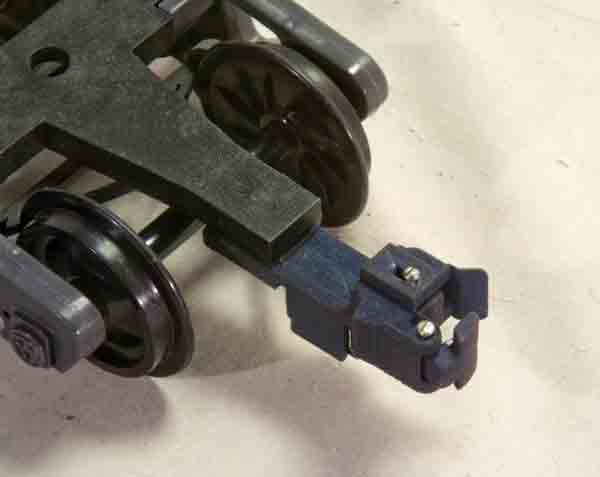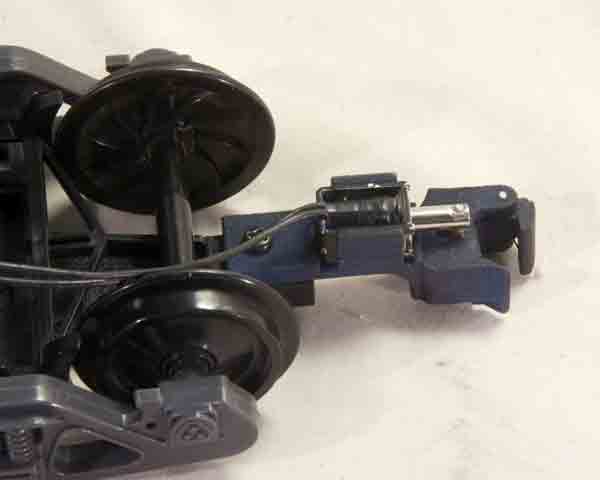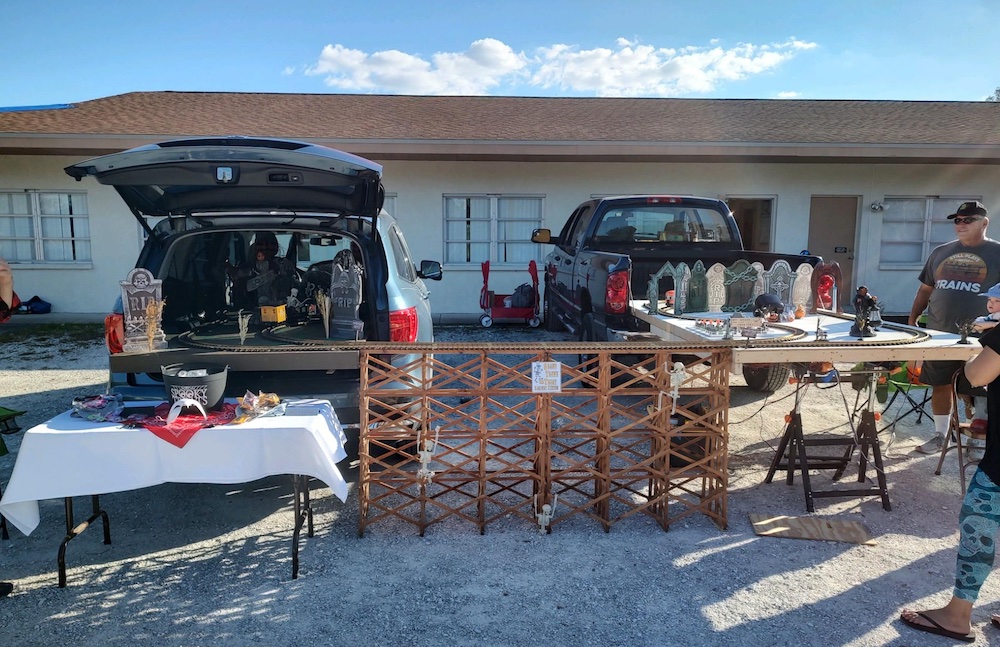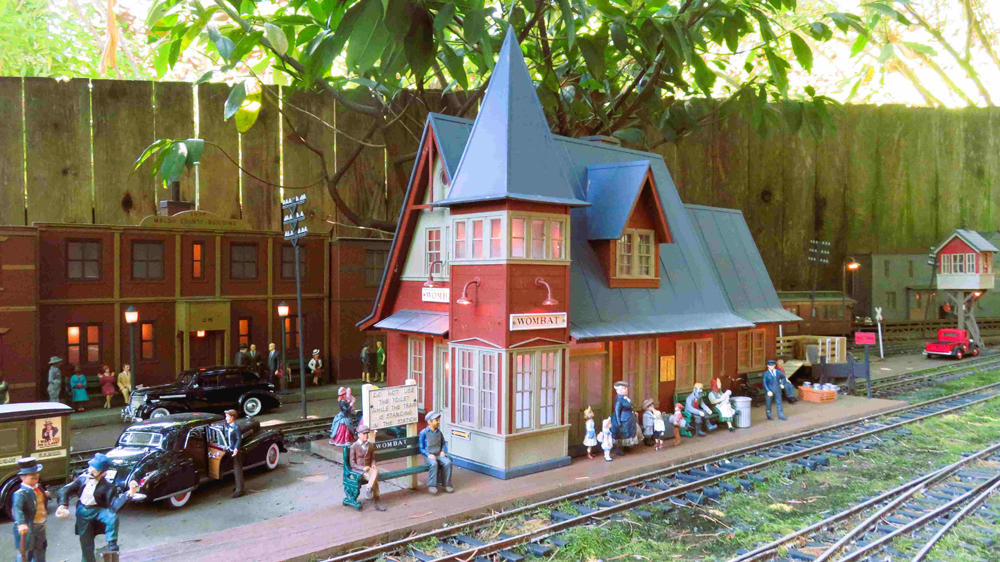Phoenix Sound Systems, Inc.
3514 West Liberty Rd.
Ann Arbor MI 48103
Price: $47
Website: www.phoenixsound.com
Large scale, remotely controlled coupler; online instruction manual
Pros: Simple installation and hook-up; compatible with a variety of manufacturers’ couplers
Cons: Available in truck-mounted configuration only
Phoenix Sound has just released a circuit board for remotely controlling couplers (see review above), and they have introduced their own remote-controlled coupler that plugs into that board.
The Phoenix coupler is a knuckle-style coupler, on par in size with the Kadee “G” scale coupler. The coupler is 3D printed in nylon. The coupler itself (exclusive of the shank) measures 11/16″ wide x 1/2″ tall x 3/4″ long. A solenoid is neatly attached to the bottom of the coupler. My review sample was dark blue, but that’s nothing a can of paint can’t fix. It operates like a prototypical coupler, in that there’s a knuckle that opens to allow the coupler to connect and disconnect from other cars. In the case of this coupler, the knuckle is spring loaded so that it pops open, and the “trip pin” is a metal rod connected to the electronic solenoid. When the solenoid is energized, it pulls this rod back, thus releasing the knuckle.
The coupler is currently only available in a truck-mounted configuration. Depending on the equipment to which you’re mounting the coupler, this could be a good or bad thing. It’s easy to mount it on a typical truck-mounted coupler arm. I mounted mine on an LGB truck for testing purposes. You may have to do some light cutting or filing to get it to fit properly, depending. If you’re going with a body-mounted coupler, you’ll have to do some fiddling to get the coupler to fit on the mount. I don’t think this would be difficult, but I do hope Phoenix releases a body-mounted version in the not-too-distant future.
My tests were conducted on my shelf railroad in my workshop. I found the coupler to be reliable. It opened and closed easily and seemed to withstand a fair amount of tension. The effects of a long, heavy train were simulated by letting the drivers of the locomotive slip, the locomotive tugging on the coupler as it did so. Under extreme loads, the coupler did occasionally come open on its own. I noticed this happening when the trip pin had worked its way backward as a result of vibration on the couplers imposed by the test. I imagine my workbench test to be a little more extreme than real-world conditions, though.
Operation of the coupler is simple. You simply energize the solenoid and it opens. How you energize the solenoid is up to you. You could use Phoenix’s remote uncoupler board or a suitable auxiliary-function output of whatever control system you’re using. You need only to energize the solenoid momentarily to open the knuckle. I found the coupler’s operation to be quite consistent.
The big question with any large-scale coupler is, does it plays well with others? Large scale is not known for widespread coupler compatibility, and stories of issues with brand X coupling to brand Q abound. I have in my collection couplers from Aristo-Craft, Bachmann, Kadee, and Accucraft. Phoenix’s literature says they’re compatible with USA Trains’ couplers; I did not have one on hand to confirm. Of all the couplers I tried, the Phoenix coupler proved most compatible with Kadee’s “G” scale coupler.
It routinely coupled and uncoupled without any problems. Only the Aristo-Craft coupler gave me trouble in terms of operation. It doesn’t fit very easily into the opening of the Phoenix coupler, so has trouble coupling and uncoupling. With the other couplers, uncoupling was consistent. When I energized the solenoid, it easily released from all the other manufacturers’ couplers. Recoupling to them was hit-or-miss but no worse than what one experiences coupling other dissimilar couplers. Sometimes a little human intervention was needed to get the trip pins to lock. It’s always been easier to get them apart than to get them together.
It’s important to note that these tests were done with the couplers mounted at the same height (1 1/8″ centerline). That’s the de-facto standard for large scale, body-mounted couplers or truck-mounted Kadee couplers. If the couplers on your equipment are not at that height, then all bets are off. It makes no difference how compatible couplers are in operation—if they’re not at the same height, there will be issues.
The bottom line is that, an automatic coupler in large scale works best when it works with the widest variety of manufacturers’ couplers. To that end, this coupler works about as well as one could expect, given the variety that exists in large scale. When couplers aren’t 100% the same, you can’t expect 100% compatibility, so one can’t really fault Phoenix’s for not meeting that standard, since there isn’t any standard. “As good as any other combination” is really about the best anyone can ask for. This one meets that expectation.














